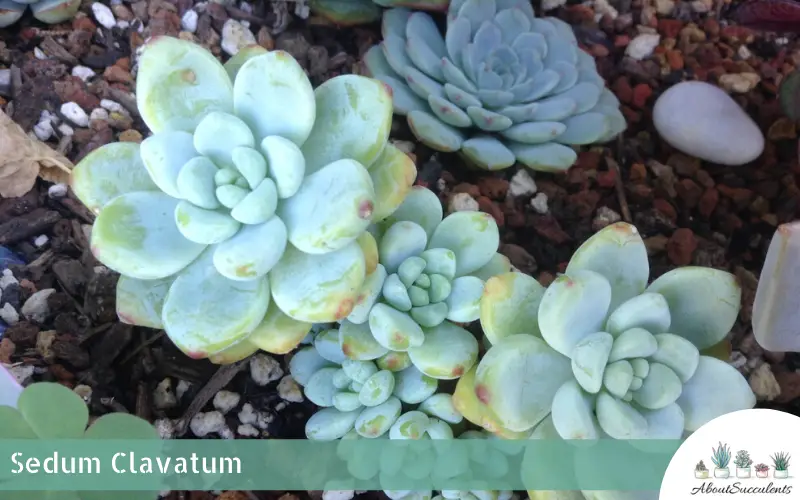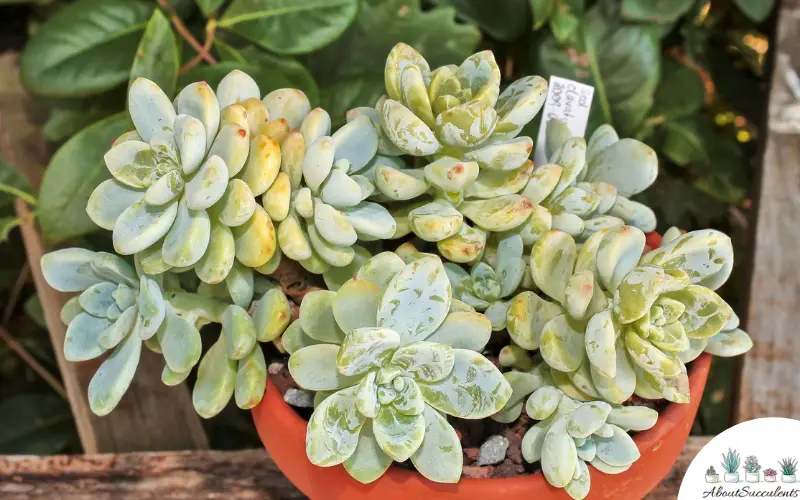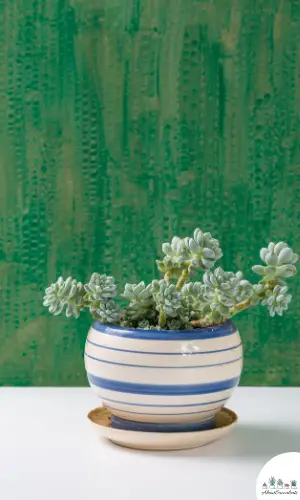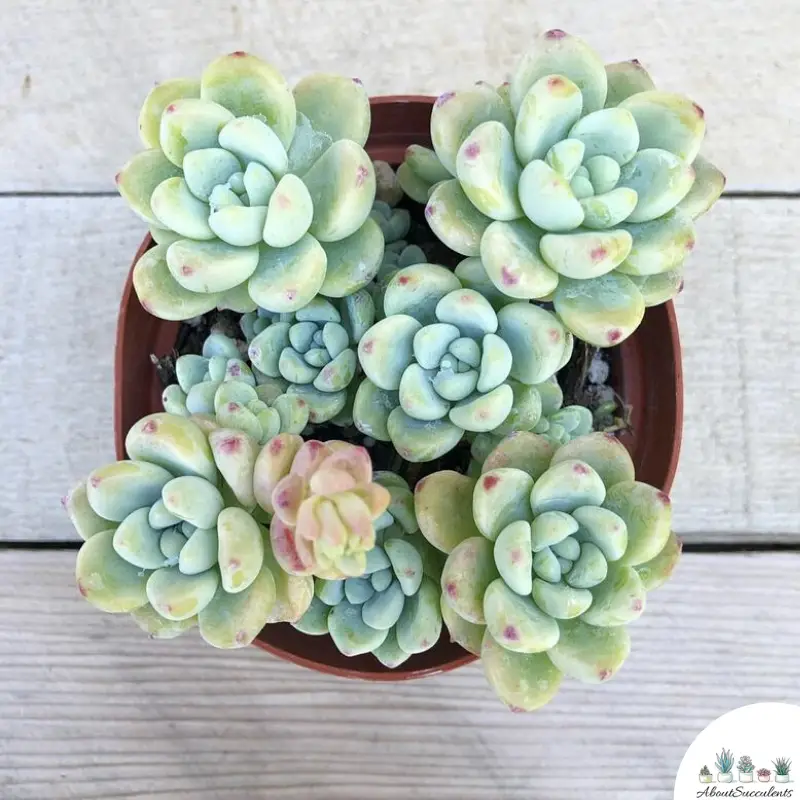
Sedum Clavatum is a beautiful succulent that can grow up to 4-inches or 10cm tall. It is identified by stout stems that extend to the rosettes which measure 2-inches or 5cm in diameter. The leaves can have a pale green or blue-green color that can sometimes have red-colored tips. As the stems continue to extend, the succulent can lose some of its leaves but the younger stems that are revealed continue to give Sedum Clavatum a thick, lush appearance matted by elegant blue-green rosettes.
Sedum Clavatum is also known as Tiscalatengo Gorge Sedum and originates from the Crassulaceae family. The Sedum Clavatum succulent is native to Mexico.
General Information:
Also Known As: Tiscalatengo Gorge Sedum
Plant Family: Crassulaceae
Origin: Mexico
Height: 4-inches (10cm tall)
Exposure: 6 hours of sunlight
Water Needs: Frequent watering in the summer; low watering in the winter
Soil Type: Cactus Mix or a combination of 3 parts potting soil, 2 parts coarse and salt-free sand, and 1 part pumice or perlite.
Soil pH: Acidic ( 5.5)
Maintenance Requirements: Low
Tolerance: Hot and dry climate
How to Grow and Care for Sedum Clavatum

Sedum Clavatum is a low maintenance succulent. It needs very little attention and care and can thrive even in the most inhospitable areas. If you have an area in the garden that either receives very little water or sunlight, plant Sedum Clavatum there and it will grow.
Another name given to this elegant succulent is Stonecrop because just like a stone, Tiscalatengo Gorge Sedum will not require much attention and it will still have a long life.
The ideal temperature to grow Sedum Clavatum is a minimum of 30° F or -1.1 ° C.
The ideal temperature range to grow Sedum Clavatum in the summer months is 5°C to 25°C (41°F to 77°F).
Sunlight

Sedum Clavatum is best grown outdoors where exposure to sunlight can transform its blue-green leaves into a mesmerizing light pink. If the succulent is grown indoors, the leaves will not produce bright colors.
Tiscalatengo Gorge Sedum is best planted in an area that receives at least 6 hours of sunlight. This succulent can also be used as a hanging plant where its leaves can be allowed to extend and trail further.
Watering
Sedum Clavatum should be planted in a pot that has good drainage. It has the same watering needs as a typical succulent. The soil has to be completely soaked in water then be allowed to dry before watering again.
Be mindful of the temperature if Sedum Clavatum is planted outside. In the summer months, the soil will dry out faster which means the succulent will require frequent watering. In the colder months, Sedum Clavatum will not require as much watering.
Pot and Soil
The most important aspect of choosing a pot for Sedum Clavatum is its drainage. This succulent cannot be immersed in water for a long time or its roots will rot. Having good drainage will allow the soil to dry out completely before the plant can be watered again.

Cactus soil is recommended for the Sedum Clavatum, as it quickly removes excess water. The Cactus soil has a pH level of 5.5 which is perfect for succulent plants.
It is recommended to have slow-release fertilizers with low to moderate nitrogen content added into the soil mix. Sedum Clavatum is best fertilized during the spring and fall seasons. Do not fertilize the succulent in the summer months.
How to Propagate Sedum Clavatum
Sedum Clavatum is easily propagated either through stem cuttings or leaves. Propagating succulents is a fun way to multiply your collection of succulents. If you used the cuttings as decoration for an event, you can re-use them to propagate Sedum Clavatum without problem or difficulty.
Stem Cutting Method
Step 1: Choose a pot that will allow a space of 2” to 3” between each stem cutting.
Step 2: Fill the pot with cactus soil or a combined mix of 3 parts potting soil, 2 parts coarse and salt-free sand, and 1 part pumice or perlite.
Step 3: Take the cut end of a stem and plant it 1” to 2” into the soil. The lowest part of the leaves should stay above the soil without touching it. Compress the soil tightly to make the cuttings stay more upright.
Leaves Method
Step 1: Allow the cut leaves to dry indoors for a period of 4 to 7 days. The leaves will be ready for planting once the cuttings develop calluses.
Step 2: Fill in the pot with the same soil type or combination mixture described in the Stem Cutting Method.
Step 3: Plant the leaves in an upright position with its cut side down. Allow a spacing of 2” to 3” between leaves.
FAQs
Sedum Clavatum is generally non-toxic for cats and dogs. The succulent does not appear in the American Society for the Prevention of Cruelty to Animals (ASPCA) website.
Your Sedum Clavatum succulent could be dying because of these 3 reasons:
1. Underwatering
Sedum Clavatum is more resilient to dry temperatures but it will flourish and grow stronger when it receives frequent watering especially during the summer months.
2. Overwatering
If Sedum Clavatum remains immersed in water for long periods, its roots will rot and infect the rest of the plant. The succulent should not receive as much water during the winter season because the soil stays moist for a longer period of time.
3. Infestation
Aphids are attracted to Tiscalatengo Gorge Sedum. It is important to have Sedum Clavatum located in an area where there is good air circulation to keep pests away and to reduce the risk of developing diseases.
Does the Sedum Clavatum Produce Flowers?
Sedum Clavatum can produce multiple small, white, star-shaped flowers from mid to late spring until early summer.
Last Updated on June 10, 2022 by Sofia Lara